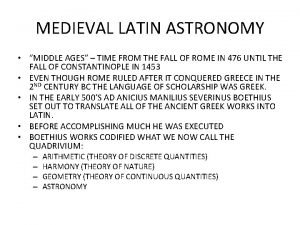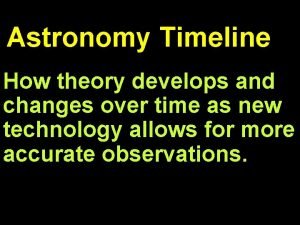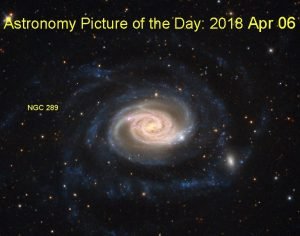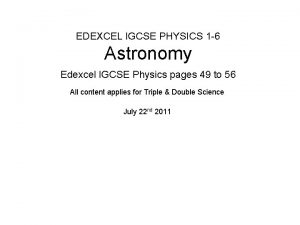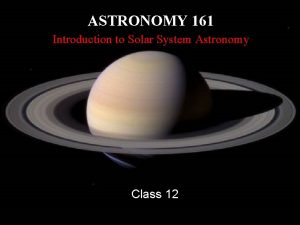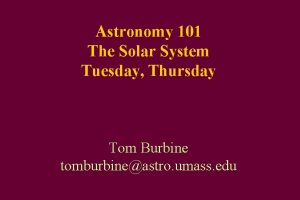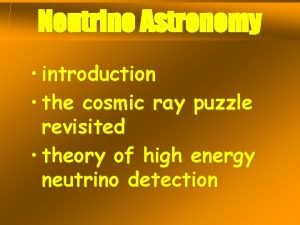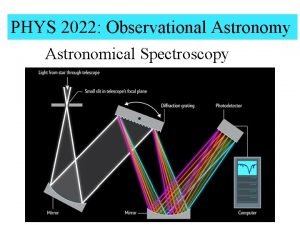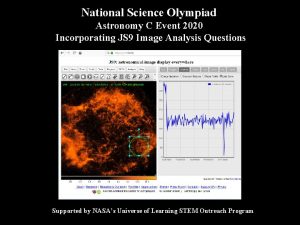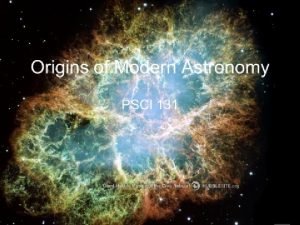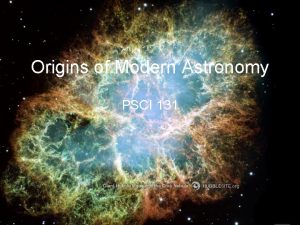PSCI 1414 GENERAL ASTRONOMY THE NATURE OF THE



























- Slides: 27

PSCI 1414 GENERAL ASTRONOMY THE NATURE OF THE STARS PART 1: STELLAR DISTANCES, LUMINOSITY, AND THE MAGNITUDE SCALE ALEXANDER C. SPAHN

PARALLAX The vast majority of stars are objects very much like the Sun. This understanding followed from the discovery that the stars are tremendously far from us, at distances so great their light takes years to reach us. Clearly, then, it is important to know how distant the stars are. But how do we measure these distances?

PARALLAX You might think these distances are determined by comparing how bright different stars appear. Perhaps the star Betelgeuse appears bright because it is relatively close, while the dimmer and less conspicuous star Polaris is farther away. But this line of reasoning is incorrect: Polaris is actually closer to us than Betelgeuse!

PARALLAX How bright a star appears is not a good indicator of its distance. If you see a light on a darkened road, it could be a motorcycle headlight a kilometer away or a person holding a flashlight just a few meters away. In the same way, a bright star might be extremely far away but have an unusually high luminosity, and a dim star might be relatively close but have a rather low luminosity.

PARALLAX The most straightforward way of measuring stellar distances uses an effect called parallax, which is the apparent displacement of an object because of a change in the observer’s point of view. To see how parallax works, hold your arm out straight in front of you. Now look at the hand on your outstretched arm, first with your left eye closed, then with your right eye closed. When you close one eye and open the other, your hand appears to shift back and forth against the background of more distant objects. The closer the object you are viewing, the greater the parallax shift.

PARALLAX To measure the distance to a star, astronomers measure the parallax shift of the star using two points of view that are as far apart as possible—at opposite sides of Earth’s orbit. The direction from Earth to a nearby star changes as our planet orbits the Sun, and the nearby star appears to move back and forth against the background of more distant stars. This motion is called stellar parallax.

PARALLAX The parallax (p) of a star is equal to half the angle through which the star’s apparent position shifts as Earth moves from one side of its orbit to the other. The larger the parallax p, the smaller the distance d to the star.

PARALLAX It is convenient to measure the distance d in parsecs. A star with a parallax angle of 1 second of arc (p = 1 arcsec) is at a distance of 1 parsec (d = 1 pc). 1 parsec = 3. 26 ly = 3. 09 × 1013 km = 206, 265 AU.

PARALLAX •

CALCULATION CHECK 17 -1 How many light-years away is Alpha Centauri if it has a parallax angle of 0. 772 arcseconds? Given that distance in parsecs is the inverse of the parallax angle, d = 1/0. 7772, then d = 1. 35 pc. Because 1 pc is 3. 26 ly, we find that 1. 35 pc × (3. 26 ly/1 pc) = 4. 4 ly.

LUMINOSITY AND BRIGHTNESS All the stars you see in the nighttime sky shine by thermonuclear fusion, just as the Sun does, but they are by no means merely identical copies of the Sun. Stars differ in their luminosity (L), the amount of light energy they emit each second. Luminosity is usually measured either in watts (1 watt, or 1 W, is 1 joule per second) or as a multiple of the Sun’s luminosity (L⊙, equal to 3. 90 × 1026 W).

LUMINOSITY AND BRIGHTNESS Imagine a star radiating light into space. As the light energy moves away from the star, it spreads out over increasingly larger regions of space—the energy thins out. Now imagine a sphere of radius d centered on the star.

LUMINOSITY AND BRIGHTNESS The amount of energy that passes each second through a square meter of the sphere’s surface area is called the brightness (b). The brightness is the total luminosity of the source (L) divided by the total surface area of the sphere (equal to 4πd 2).

LUMINOSITY AND BRIGHTNESS This quantity is also called the apparent brightness (b), because how bright a light source appears depends on how far away it is being observed. Apparent brightness is measured in watts per square meter (W/m 2).

THE INVERSE SQUARE LAW •

CALCULATION CHECK 17 -2 How many times less light falls on a book illuminated by a lightbulb if the book is moved a distance of 3 times farther away? According to the inverse-square law nature of light, the intensity of the light received decreases with the square of the distance. In this instance, increasing the distance 3 times means the book receives only 1/(3)2 or oneninth the amount of light it originally received.

CALCULATING LUMINOSITY •

CALCULATING LUMINOSITY •

CALCULATING LUMINOSITY •

CALCULATION CHECK 17 -3 The star Pleione in the constellation Taurus is 190 times as luminous as the Sun but appears only 3. 19 × 10− 13 as bright as the Sun. How many times farther is Pleione from Earth compared to the Earth-Sun distance? Pleione’s luminosity relative to that of the Sun is L/L⊙ = 190. The ratio of their apparent brightnesses is b/b⊙ = 3. 19 × 10− 13. Rearranging the equation relating luminosity, distance, and brightness yields the distance from Earth to Pleione as 2. 44 × 107 times greater than the distance from Earth to the Sun:

THE STELLAR POPULATION As stars go, our Sun is neither extremely luminous nor extremely dim; it is a rather ordinary, garden-variety star. It is somewhat more luminous than most stars, however. To better characterize a typical population of stars, astronomers count the stars out to a certain distance from the Sun and plot the number of stars that have different luminosities. The resulting graph is called the luminosity function.

APPARENT MAGNITUDES The magnitude scale is often used by astronomers to denote the brightness of stars. The magnitudes in this scale are properly called apparent magnitudes, because they describe how bright an object appears to an Earth-based observer. Apparent magnitude is directly related to apparent brightness.

APPARENT MAGNITUDES The smaller the number, the brighter a star appears. A magnitude difference of 1 corresponds to a factor of 2. 512 in brightness. For example, a first-magnitude star is 2. 512 times brighter than a secondmagnitude star.

APPARENT MAGNITUDES The smaller the number, the brighter a star appears. A magnitude difference of 1 corresponds to a factor of 2. 512 in brightness. For example, a first-magnitude star is 2. 512 times brighter than a secondmagnitude star.

ABSOLUTE MAGNITUDES Apparent magnitude is a measure of a star’s apparent brightness as seen from Earth. A related quantity that measures a star’s true energy output—that is, its luminosity—is called absolute magnitude. This is the apparent magnitude a star would have if it were located exactly 10 parsecs from Earth.

DISTANCE MODULUS •

FOR NEXT TIME… • Read the rest of Chapter 17 • Homework 17: Chapter 17 questions 4, 5, 8, 34, 41, 46, 48 a (Due Wednesday, April 6 th) Warning: Math problems! *Hints given on website* • Exam 3: Wednesday, April 13 th (Chapters 5, 16, and 17)
 Jeremias 1414 falsos profetas
Jeremias 1414 falsos profetas Learning astronomy by doing astronomy
Learning astronomy by doing astronomy Learning astronomy by doing astronomy answers
Learning astronomy by doing astronomy answers Learning astronomy by doing astronomy
Learning astronomy by doing astronomy Psci audit
Psci audit Pharmaceutical supply chain initiative psci
Pharmaceutical supply chain initiative psci Pharmaceutical supply chain initiative psci
Pharmaceutical supply chain initiative psci Nature nature controversy
Nature nature controversy Nature and nature's laws lay hid in night
Nature and nature's laws lay hid in night Permanent states ejemplo
Permanent states ejemplo Diferencia entre gran plano general y plano general
Diferencia entre gran plano general y plano general Where did general lee surrender to general grant?
Where did general lee surrender to general grant? Astronomy pseudoscience
Astronomy pseudoscience Astronomy in medieval times
Astronomy in medieval times Astronomy
Astronomy Astronomy timeline project
Astronomy timeline project Astronomy picture of the day 17 april 2001
Astronomy picture of the day 17 april 2001 Astronomy igcse
Astronomy igcse Solar system astronomy class
Solar system astronomy class Netherlands institute for radio astronomy
Netherlands institute for radio astronomy What is astronomy vs astrology
What is astronomy vs astrology Astronomy 101 formulas
Astronomy 101 formulas Astronomy
Astronomy Astronomy
Astronomy Ebit
Ebit Branches of astronomy
Branches of astronomy Science olympiad astronomy
Science olympiad astronomy Seray arslan
Seray arslan













